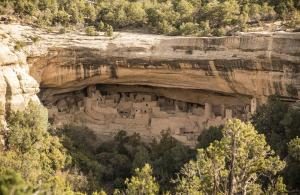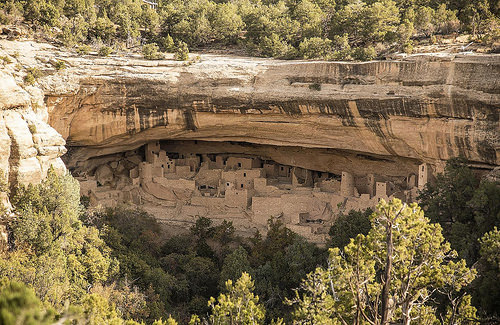
UNIVERSITY OF COLORADO AT BOULDER—Aug. 10, 2017–Ancient DNA used to track the mass exodus of Ancestral Pueblo people from Colorado’s Mesa Verde region in the late 13th century indicates many wound up in the Northern Rio Grande area north of Santa Fe, New Mexico, inhabited today by the Tewa Pueblo people.
Here’s the twist: The DNA came from domesticated turkeys that had been kept by ancient Pueblo people in both places, according to University of Colorado Boulder Assistant Professor Scott Ortman, one of four lead study authors. The study indicates DNA from turkey bones unearthed at Mesa Verde matched the turkey DNA in the northern Rio Grande area after the Mesa Verde society buckled.
“What we found was good evidence of a substantial influx of turkeys into the northern Rio Grande region that had the same genetic composition as turkeys from the Mesa Verde region,” Ortman said. “This is a new line of evidence suggesting a strong connection between contemporary Tewa Pueblo people in New Mexico and the Pueblo people who lived in Mesa Verde country before its collapse.”
A paper on the subject was published in a recent issue of the science journal PLOS ONE. In addition to Ortman, the study included co-authors from Washington State University, the University of California, Davis and the University of Oklahoma.
The Mesa Verde region was a hub of Southwest Puebloan society, populated by as many as 30,000 people in the middle of the 13th century, Ortman said. But a severe drought in 1277, coupled with resource depletion and social upheaval, is thought to have triggered a massive migration south to New Mexico and Arizona by the end of the 13th century.
For the study, Ortman and his colleagues used mitochondrial DNA–which is passed down from mother to offspring–extracted from turkey bones buried in the Mesa Verde region before the migration and mitochondrial DNA collected from the northern Rio Grande region before and after the Mesa Verde was abandoned.
Turkeys had been kept as a source of feathers to make blankets and other goods by the Mesa Verde inhabitants before A.D. 1000, Ortman said. But after that the archaeological record shows the Mesa Verde people began raising the turkeys as a meat source, causing turkey bones to become much more common in the archaeological record.
The study showed the genetic composition of the turkey population in the northern Rio Grande changed substantially before and after the Mesa Verde exodus. Since the genetic composition of the northern Rio Grande turkeys after the migration period was genetically indistinguishable from the birds that lived in the Mesa Verde country before the migration, it appears the migrating people took their turkeys with them, he said.
Ortman said the people fleeing the Mesa Verde area in the 13th century likely moved to many places in present-day New Mexico and Arizona during the great migration.
“The argument we are making is that a sizable chunk of the Mesa Verde population moved to the northern Rio Grande region,” Ortman said. “And this group of migrants stimulated the formation of the Tewa Pueblo people that live in the area.”
Previously, Ortman and his colleagues used biological, linguistic, oral tradition and material culture evidence to suggest that the ancestors of the Tewa-speaking Pueblo people in New Mexico lived in the Mesa Verde region and migrated to the northern Rio Grande during the 13th century. The recent study is the first ever to use ancient DNA to look at the scientific puzzle, Ortman said.
While the research team also looked at mitochondrial DNA from what were thought be domestic dogs buried at Mesa Verde and in the northern Rio Grande area, it did not pan out for an interesting reason, Ortman said. While the remains of most of the Mesa Verde canids were genetically dogs, almost all of the canids buried in the northern Rio Grande–traditionally thought to be dogs–were actually coyotes.
“It’s an interesting puzzle as to why the northern Rio Grande people buried so many coyotes,” he said.
____________________________________________________
Ancient remains of the Mesa Verde Pueblo people of southwest Colorado. Credit: National Park Service
____________________________________________________
Article Source: University of Colorado at Boulder news release
____________________________________________________
Receive 30 days free access to the popular new CuriosityStream lineup of documentaries on science, history, nature, and technology as a new Popular Archaeology premium subscriber.
___________________________________________
Travel and learn with Far Horizons.
____________________________________________
This richly illustrated issue includes the following stories: Recent findings shedding new light on the whereabouts of the remains of Philip of Macedon, father of Alexander the Great; how an archaeologist-sculptor is bringing bones of the dead back to life; archaeologists uncovering town life at the dawn of civilization; an exclusive interview with internationally acclaimed archaeologist James M. Adovasio about what makes the Meadowcroft Rockshelter prominent in the ongoing search for the first Americans; what archaeologists are finding at the site of the ancient city of Gath, the home town of the biblical Philistine giant, Goliath; and how scientists are redrawing the picture of human evolution in Europe. Find it on Amazon.com.






